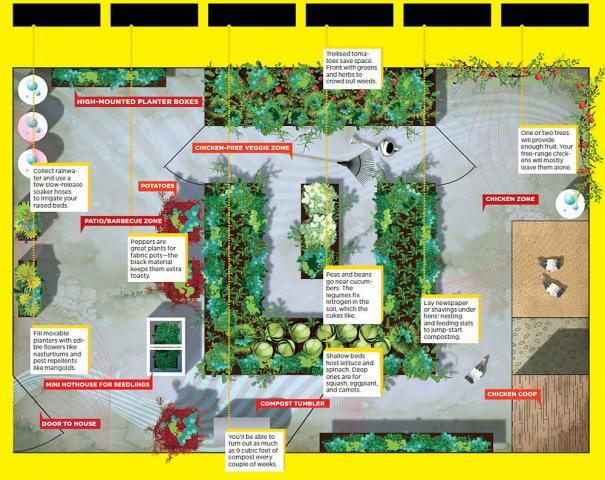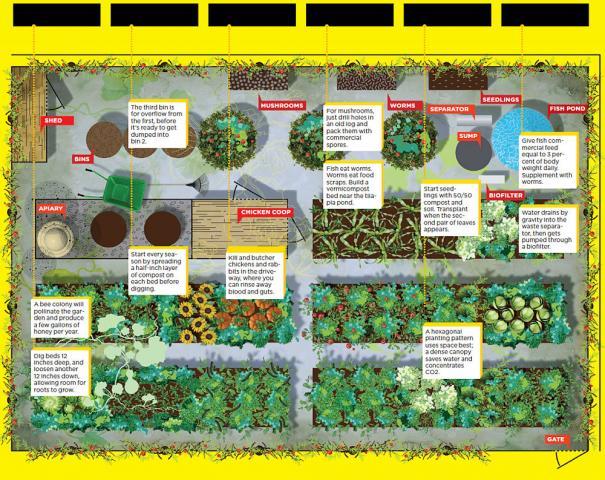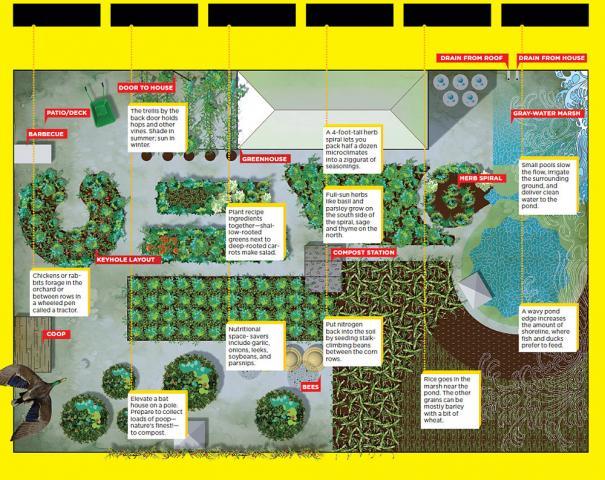In this interesting article from Wired magazine called "Geek Gardening: A Wired Guide To Domestic Terraforming," there are three backyard garden set-ups that include chickens and a coop. What I like about the approach is showing that just about any backyard can have chickens where ordinances allow it:
1. 20' x 30' : "The postage stamp behind your row house has enough room for several raised beds that, combined with fence-mounted planter boxes and movable containers, should sate the fruit and vegetable appetites of a family of four in summer and fall. A small potato crop piles on some additional calories, and three laying hens will supply you with eggs for most of the year. Plus, chicken poop provides a nitrogen-rich base for your compost tumbler. Your little ecosystem wont exactly save you moneyif you figure that organic feed is 72 cents a pound and the birds will each eat 2 pounds of chow a week, the dozen or so eggs youll get weekly will cost around $4."
Chickens and Eggs
"If city regulations permit, you have just enough room for laying hens (keep three or more for ideal flock dynamics). House your egg factories in a three-room condo with an enclosed, slat-floored nesting/laying level at a height good for gathering eggs and cleaning up; a mesh-enclosed, slat-floored lower-level platform for fowl to eat and drink; and a ground-level sandbox for scratching and dusting."

2. 32' x 48' : "High-quality animal protein isnt sustainable, but it sure is delicious. A few laying hens will gobble up kitchen scraps, bugs from fallow garden beds, pests you hand-pick off crops, and crickets. (Raise your own in a tall container indoors; youll need a dozen males and a dozen females to start.)"

3. 40' x 60' : "Chickens convert feed to flesh super efficiently. (Raise eight chicks at a time and give them the ax at two months to keep the freezer stocked.) Dual-purpose breeds like Barred Plymouth Rock also provide eggs. Supplement their diet with snails and sic them on the bugs in your orchard."

Here's the whole article: http://www.wired.com/magazine/2010/05/ff_domestic_terraforming/
1. 20' x 30' : "The postage stamp behind your row house has enough room for several raised beds that, combined with fence-mounted planter boxes and movable containers, should sate the fruit and vegetable appetites of a family of four in summer and fall. A small potato crop piles on some additional calories, and three laying hens will supply you with eggs for most of the year. Plus, chicken poop provides a nitrogen-rich base for your compost tumbler. Your little ecosystem wont exactly save you moneyif you figure that organic feed is 72 cents a pound and the birds will each eat 2 pounds of chow a week, the dozen or so eggs youll get weekly will cost around $4."
Chickens and Eggs
"If city regulations permit, you have just enough room for laying hens (keep three or more for ideal flock dynamics). House your egg factories in a three-room condo with an enclosed, slat-floored nesting/laying level at a height good for gathering eggs and cleaning up; a mesh-enclosed, slat-floored lower-level platform for fowl to eat and drink; and a ground-level sandbox for scratching and dusting."

2. 32' x 48' : "High-quality animal protein isnt sustainable, but it sure is delicious. A few laying hens will gobble up kitchen scraps, bugs from fallow garden beds, pests you hand-pick off crops, and crickets. (Raise your own in a tall container indoors; youll need a dozen males and a dozen females to start.)"

3. 40' x 60' : "Chickens convert feed to flesh super efficiently. (Raise eight chicks at a time and give them the ax at two months to keep the freezer stocked.) Dual-purpose breeds like Barred Plymouth Rock also provide eggs. Supplement their diet with snails and sic them on the bugs in your orchard."

Here's the whole article: http://www.wired.com/magazine/2010/05/ff_domestic_terraforming/

